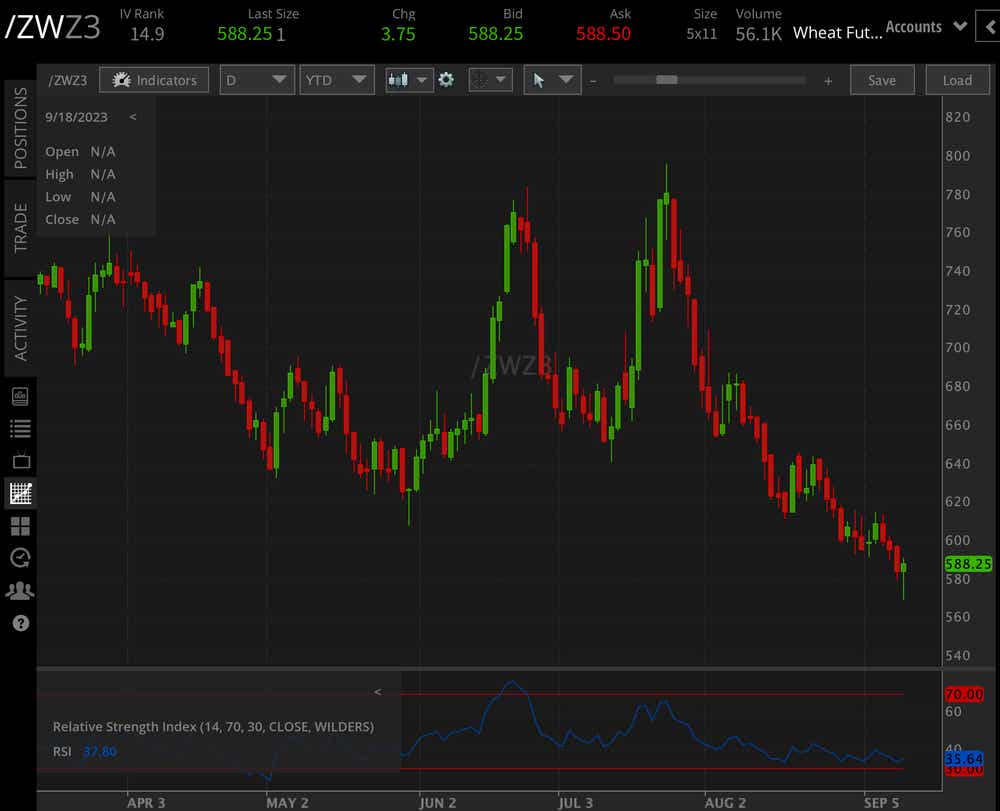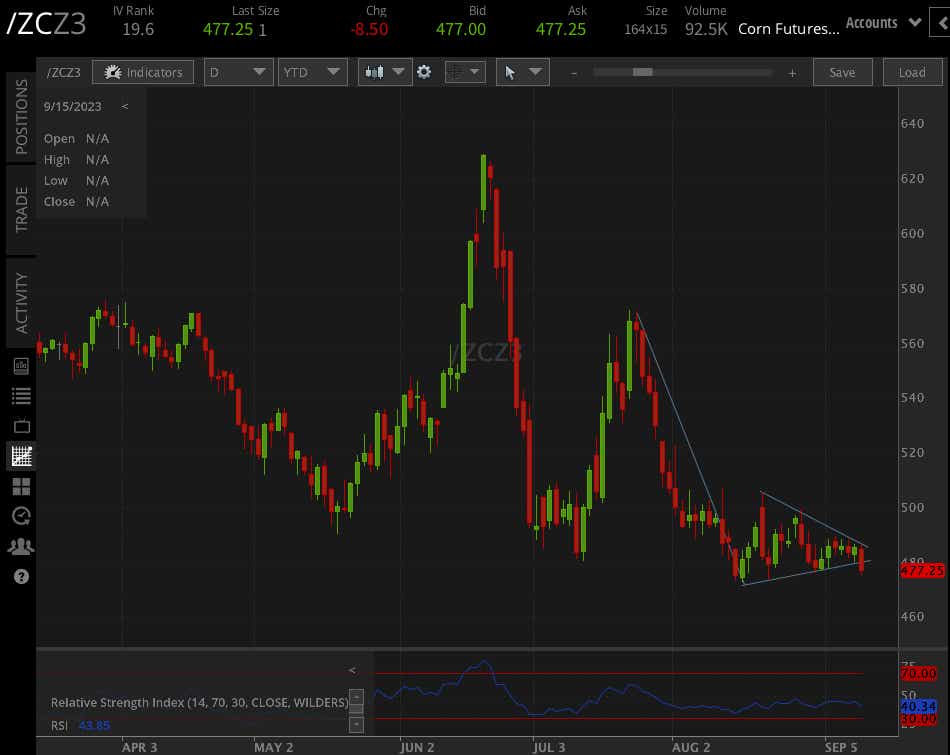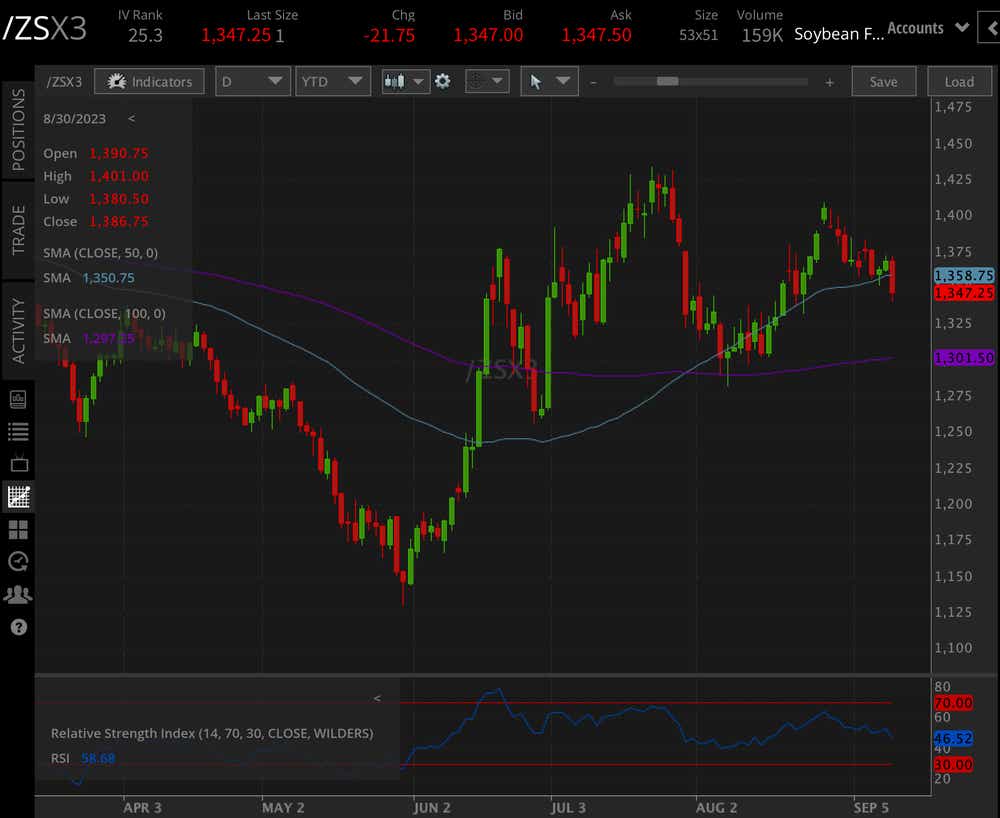WASDE Recap: Bears Remain in Control

WASDE Recap: Bears Remain in Control
The monthly WASDE report contains projections for commodities in the United States and around the world
- The September WASDE report keeps the bear narrative alive.
- Wheat ending stocks declined, and corn ending stocks rose.
- Soybeans were put under pressure as the WASDE price forecast dropped.
The highly anticipated World Agricultural Supply and Demand Estimates—commonly referred to as the WASDE report and released by the World Agricultural Outlook Board (WAOB)—crossed the wires today and resulted in some notable moves across the commodities market. But there weren’t any huge surprises for any specific commodity.
What is the WASDE report?
The monthly report contains projections for commodities in the United States and the rest of the world. The National Agricultural Statistics Service (NASS) provides the data to the nine Interagency Commodity Estimates Committees (ICECs) that make the projections found in the report. The United States Department of Agriculture’s Foreign Agricultural Service also provides data it gathers from foreign agencies, along with broader weather and satellite data.
Wheat outlook
Wheat futures (/ZWZ3) initially declined following the WASDE, but prices were trading higher in the early afternoon session Tuesday, although the commodity remains near its lowest level since December 2020.
For the 2023/24 projection, the outlook is for stocks to decline from last month’s report, with a 7.2 million ton reduction to 1,054.5 million tons. While Ukrainian production grew, those gains couldn’t make up for production losses in Australia, Canada, Argentina and the European Union.
World ending stocks fell by 7 million tons to 258.7 million, the lowest since the 2015/16 season. U.S. ending stocks were unchanged at 16.75 million tons. The projected farm price for 2023/24 is unchanged at $7.5 per bushel.
While the report is slightly bullish for wheat prices, the commodity faces a tough technical path as it remains well below all its key moving averages. The price has been driven down by bumper wheat exports from Russia despite Moscow’s withdrawal from the Black Sea Grain Initiative.

Corn outlook
Corn futures (/ZCZ3) are being hammered following the WASDE as traders digest higher U.S. ending stocks, which increased in September by 19 million bushels to 2.2 billion on higher supply and unchanged demand.
The 2023/24 season-average corn price for producers was unchanged at $4.90 per bushel. While Ukrainian production is seen higher, it failed to overcome declines across the European Union (EU). The WASDE report puts world ending stocks up 2.9 million tons to 314 million.
Corn prices broke down from a pennant pattern following the WASDE, with prices breaching the pattern’s support level. The measured move—gauged by the pattern’s widest point—would put a target at around 447.

Soybeans outlook
Soybean futures (/ZSX3) are trading down 1.5% following the report. U.S. ending stocks fell 25 million bushels from 245 to 220, with lower beginning stocks and production influencing the figure.
While the report increased its average farm price for the 2023/24 projection from last month to 12.9 from 12.7 per bushel, that is still below the current comparable trading price in front-month futures. That projection could weigh on sentiment in the coming months. Overall, it’s a slightly bearish to neutral report for /ZS.
Prices for /ZS are trading around its 50-day simple moving average (SMA) and are among the most volatile of the three products discussed in this article over the last 30 days. A break lower if traders decide to follow through with selling could threaten the 100-day SMA, which is a likely scenario in my view, given that ending stocks didn’t decrease as much as needed to support current prices.

Thomas Westwater, a tastylive financial writer and analyst, has eight years of markets and trading experience. @fxwestwater
For live daily programming, market news and commentary, visit tastylive or the YouTube channels tastylive (for options traders), and tastyliveTrending for stocks, futures, forex & macro.
Trade with a better broker, open a tastytrade account today. tastylive, Inc. and tastytrade, Inc. are separate but affiliated companies.
Options involve risk and are not suitable for all investors. Please read Characteristics and Risks of Standardized Options before deciding to invest in options.
tastylive content is created, produced, and provided solely by tastylive, Inc. (“tastylive”) and is for informational and educational purposes only. It is not, nor is it intended to be, trading or investment advice or a recommendation that any security, futures contract, digital asset, other product, transaction, or investment strategy is suitable for any person. Trading securities, futures products, and digital assets involve risk and may result in a loss greater than the original amount invested. tastylive, through its content, financial programming or otherwise, does not provide investment or financial advice or make investment recommendations. Investment information provided may not be appropriate for all investors and is provided without respect to individual investor financial sophistication, financial situation, investing time horizon or risk tolerance. tastylive is not in the business of transacting securities trades, nor does it direct client commodity accounts or give commodity trading advice tailored to any particular client’s situation or investment objectives. Supporting documentation for any claims (including claims made on behalf of options programs), comparisons, statistics, or other technical data, if applicable, will be supplied upon request. tastylive is not a licensed financial adviser, registered investment adviser, or a registered broker-dealer. Options, futures, and futures options are not suitable for all investors. Prior to trading securities, options, futures, or futures options, please read the applicable risk disclosures, including, but not limited to, the Characteristics and Risks of Standardized Options Disclosure and the Futures and Exchange-Traded Options Risk Disclosure found on tastytrade.com/disclosures.
tastytrade, Inc. ("tastytrade”) is a registered broker-dealer and member of FINRA, NFA, and SIPC. tastytrade was previously known as tastyworks, Inc. (“tastyworks”). tastytrade offers self-directed brokerage accounts to its customers. tastytrade does not give financial or trading advice, nor does it make investment recommendations. You alone are responsible for making your investment and trading decisions and for evaluating the merits and risks associated with the use of tastytrade’s systems, services or products. tastytrade is a wholly-owned subsidiary of tastylive, Inc.
tastytrade has entered into a Marketing Agreement with tastylive (“Marketing Agent”) whereby tastytrade pays compensation to Marketing Agent to recommend tastytrade’s brokerage services. The existence of this Marketing Agreement should not be deemed as an endorsement or recommendation of Marketing Agent by tastytrade. tastytrade and Marketing Agent are separate entities with their own products and services. tastylive is the parent company of tastytrade.
tastyfx, LLC (“tastyfx”) is a Commodity Futures Trading Commission (“CFTC”) registered Retail Foreign Exchange Dealer (RFED) and Introducing Broker (IB) and Forex Dealer Member (FDM) of the National Futures Association (“NFA”) (NFA ID 0509630). Leveraged trading in foreign currency or off-exchange products on margin carries significant risk and may not be suitable for all investors. We advise you to carefully consider whether trading is appropriate for you based on your personal circumstances as you may lose more than you invest.
tastycrypto is provided solely by tasty Software Solutions, LLC. tasty Software Solutions, LLC is a separate but affiliate company of tastylive, Inc. Neither tastylive nor any of its affiliates are responsible for the products or services provided by tasty Software Solutions, LLC. Cryptocurrency trading is not suitable for all investors due to the number of risks involved. The value of any cryptocurrency, including digital assets pegged to fiat currency, commodities, or any other asset, may go to zero.
© copyright 2013 - 2025 tastylive, Inc. All Rights Reserved. Applicable portions of the Terms of Use on tastylive.com apply. Reproduction, adaptation, distribution, public display, exhibition for profit, or storage in any electronic storage media in whole or in part is prohibited under penalty of law, provided that you may download tastylive’s podcasts as necessary to view for personal use. tastylive was previously known as tastytrade, Inc. tastylive is a trademark/servicemark owned by tastylive, Inc.